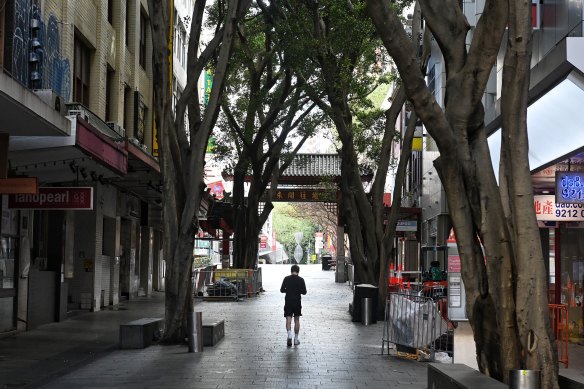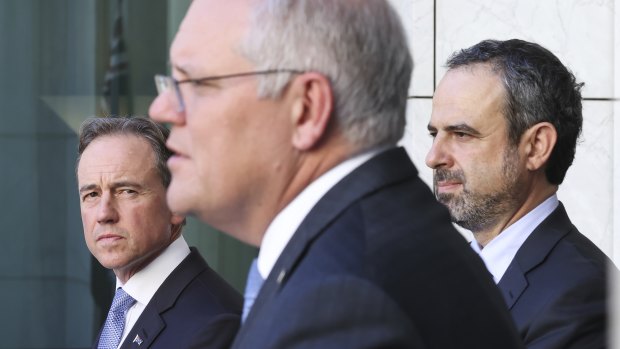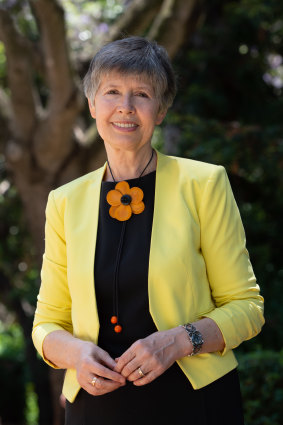This was published 3 years ago
Reopening, resistance and the long tail of ‘zero COVID’
A week after Victorian Premier Daniel Andrews gave up on “zero COVID” and conceded vaccination would be the way to end lockdowns in his state, the head of the Victorian branch of the Australian Medical Association, Roderick McRae, made the case to lock down certain areas even harder.
He argued all essential services including supermarkets should be closed for seven days (except for medical). People would get a couple of days warning to stock their shelves and prepare. “This would not be a typical lockdown, it would be a freeze to minimise movement and reduce transmission,” McRae told The Age and the Herald. “What we have done so far is not working.”

Even as the conversation in government and around kitchen tables has shifted in favour of living with the virus, a rump of activists still argue in favour of elimination.Credit: Nick Moir
The idea garnered little traction. But it is a stark example of the extreme positions on COVID still being staked out in the medical establishment, the academy and parts of the media - even as governments and ordinary Australians recast the virus from something we must keep out to a feature of life we can learn to live with.
While the prospect of eliminating COVID-19 lost much of its appeal and relevance with the arrival of the Delta variant and the advent of highly effective vaccines, as a concept and principle it is still very much alive under new guises and slogans.
Last week News Corp newspapers published a comment piece by respiratory health researcher Dr Igor Gonda advocating pre-planned “regular nationwide lockdowns” for two weeks every two months to help curtail the caseload.
On social media, commentators with large followings still advocate elimination and rail against what they portray as a government-led attempt to inflict COVID-19 on the community. University of NSW adjunct professor Bill Bowtell regularly claims to his 35,000 Twitter followers that the NSW government deliberately let the Delta variant circulate in order to emulate the United Kingdom (despite the NSW government putting Sydney in lockdown for 12 weeks and counting).
The AMA has been a vocal campaigner for tougher and faster lockdowns in response to COVID-19 outbreaks, and it is concerned about the NSW plan to start reopening when 70 per cent of the adult population is fully vaccinated - a few weeks away - despite a high caseload.
In Victoria, McRae argues restrictions should not be eased until two weeks after 80 per cent of the 12+ population is double jabbed. Only then should we “see where the wind is blowing”, he says.
The AMA’s federal council has taken a slightly different approach. Its latest communique, released today, broadly backs the Doherty Institute’s modelling for opening when 70 and 80 per cent of the 16+ population is fully vaccinated. But it warns the plan must be approached with caution - that a high caseload, as is the case in Sydney, should mean easing restrictions at a slower pace to ensure the hospitals and contact tracers can keep up.
AMA president Omar Khorshid pitches the communique as a “middle ground” approach between strong views. One side is “pushing too hard” to open up now, he says, while on the other side there were “Chicken Littles” who wanted to wait until the country reached extreme levels of vaccination.

Health Minister Greg Hunt, Prime Minister Scott Morrison and president of the Australian Medical Association, Dr Omar Khorshid, at a COVID press conference in Canberra earlier this year. Credit: Alex Ellinghausen
“What we’re saying is if you do the right things, if you follow the Doherty report properly and not just pick the bits you like, there is a path out of this,” Khorshid says. “If we follow the science, there is a safe way forward.”
The latest cautionary voice to enter the debate is OzSAGE, which formed in August to proffer “well-researched and robustly debated independent expert advice” among what it recognises as a sea of competing views about managing the next phase of the pandemic.
The group has significant academic and clinical heft. Its 11-person executive includes University of Melbourne professor Nancy Baxter, Burnet Institute deputy director Professor Margaret Hellard, UNSW economics professor Richard Holden, field epidemiologist Kamalini Lokuge and University of Sydney public health professor and deputy vice-chancellor Lisa Jackson Pulver.
Another executive member, Professor Lidia Morawska of Queensland’s University of Technology, was last week named among Time magazine’s 100 most influential people of 2021 for her work “recognising the importance of aerosol transmission [of COVID] and marshalling the data that would convince the World Health Organisation and other authoritative bodies to do the same”.

OzSAGE member QUT Professor Lidia Morawska has been named on Time’s annual 100 most influential people list.
Other big names have also signed up as OzSAGE members, including ANU vice-chancellor Brian Schmidt, Burnet Institute chief executive Brendan Crabb, epidemiologist Tony Blakely, Medical Journal of Australia editor-in-chief Nick Talley, former MP Dr Kerryn Phelps and dozens more.
Among the group’s seven principles is that Australia should “aspire to elimination” of COVID-19, like with measles, where occasional incursions are contained without significant community spread. It argues this can be achieved through booster jabs and other health measures, while continuing our normal lives.
One of the group’s core arguments is that vaccination is not enough to curb the Delta variant. It wants other provisions in place, too: improved ventilation in public spaces, particularly classrooms; enhanced contact tracing; and prolonged, widespread use of masks. It calls this suite of measures “vaccines-plus”.
One of OzSAGE’s executive members, Melbourne-based doctor Benjamin Veness, says the group is not against reopening, but wants a plan that does not lead to the health system being overwhelmed. “We’d really like to avoid that boom and bust cycle of lockdowns and instead have a path to reopening that’s sustainable from the outset,” he says.
That concern is not without foundation. OzSAGE members have spent the past week pointing to the rising number of cases in Canada’s Alberta province, where 71.5 per cent of the population over 12 is fully vaccinated. Premier Jason Kenney declared a public health emergency on Wednesday, warning the province could run out of ICU beds and staff. He also reimposed restrictions including vaccine passports and a work-from-home order.
[There were 896 people in hospital in Alberta on Friday, and 222 in ICU, from a population of 4.4 million. Paediatrician Greg Kelly, another member of the OzSAGE executive, tweeted that the province was “COLLAPSING BEFORE OUR EYES”.]
OzSAGE urges Australia to model its plans more closely on Singapore, where 90 per cent of over-12s are now vaccinated. Even that country is grappling with a rising number of cases, although the proportion of people becoming seriously ill is low due to the highly effective vaccines.
In the midst of this, NSW has announced one of the world’s most cautious reopening plans. Only those who are fully vaccinated will be able to visit venues and events, and home gatherings will initially be limited to just five vaccinated people. Schools will return under a staggered start; masks, QR code check-ins and contact tracing will remain.
OzSAGE has been quick to warn the NSW and national plans to open up when 70 and 80 per cent of the 16+ population is fully vaccinated is too fast and too risky, but it has been less willing to put a number on exactly when the reopening should occur.
While nobody disputes the aim of vaccinating as many people as possible, as long as the country’s two major cities are in long, harsh and unsustainable lockdowns, the key question is when and how to make them end.
“Ending these kinds of lockdowns will take vaccination plus other measures, especially improved ventilation,” Veness says. “I think the answer is you can’t just sit there and say ‘X, Y and Z are definitely going to happen’. You have to treat it a little bit like a dance; you relax a bit and see what happens.”
OzSAGE has quickly attracted critics. Daily Telegraph political editor James Morrow branded it “the umbrella group for the COVID alarmist wing of the country’s scientific community”, overly cautious and puritanical about crushing the virus.
Former deputy chief medical officer Nick Coatsworth said the group was on the extreme end of the risk spectrum. “I think there is a genuine concern among OzSAGE that the morbidity and mortality of COVID-19 is not over,” he said.
“They are genuinely worried about the potential for further waves in the Australian community. However, the position of their academics on risk has consistently overplayed the consequences of COVID spread, underplayed the negative effects of COVID restrictions, and frankly their thinking belongs in 2020.”
Veness says OzSAGE has shared its advice with governments but is yet to directly brief any leaders. The group, based on the UK’s Independent SAGE, has successfully courted some mainstream media coverage, generating 23 mentions in print and online so far this month according to media monitor Streem.
Many of its members are prominent COVID commentators in their own right; Streem found Blakely, Baxter and Crabb have each been mentioned more than 200 times this year in the major print and online titles (this doesn’t include radio and TV).
University of NSW epidemiologist Mary-Louise McLaws, who had 740 mentions and is well known for her cautious approach to COVID, declined an offer to join OzSAGE. “I think it’s a great initiative but I just don’t have the time,” she says.
McLaws shares many of the group’s concerns about hospital capacity, vaccine coverage and quarantine facilities, though she places more emphasis on the need for Australia to embrace rapid antigen testing as a tool to help reopen quickly and safely. And while she thinks Australia should aim for 95 per cent vaccination, she says it’s not possible to keep society locked down until then.
“You do need to get people out of lockdown,” McLaws says. “Even from my perspective of where I was - I was fully supportive of the government’s elimination [strategy] - but this is Delta now, and we’ve got rapid antigen testing and we’ve got good masks.”
McLaws is also wary of the barrage of modelling from various groups - the Doherty Institute, Burnet Institute, Grattan Institute and OzSAGE among them - that is being used to justify various positions or prognostications. She says modelling is most useful when multiple models are compared and interpreted by an outbreak manager who understands the “granular context”.
“Models should not be used to dictate how we deal with the pandemic steps,” McLaws says. “They help to catastrophise and work out what happens if we don’t do certain things ... how many beds do we need, how many staff do we need, how many deaths will we have if we do nothing.”
Schmidt, the ANU vice-chancellor, said his involvement with OzSAGE was motivated by a desire to better connect the country’s leaders with a broad range of COVID-19 experts and quality research.
He said there was a lack of transparency in the evidence underpinning decisions by state, territory and federal governments. “My involvement in OzSAGE is not exclusive, nor is it an endorsement of any of the work produced by the group unless I explicitly endorse it.”
Stay across the most crucial developments related to the pandemic with the Coronavirus Update. Sign up to receive the weekly newsletter.